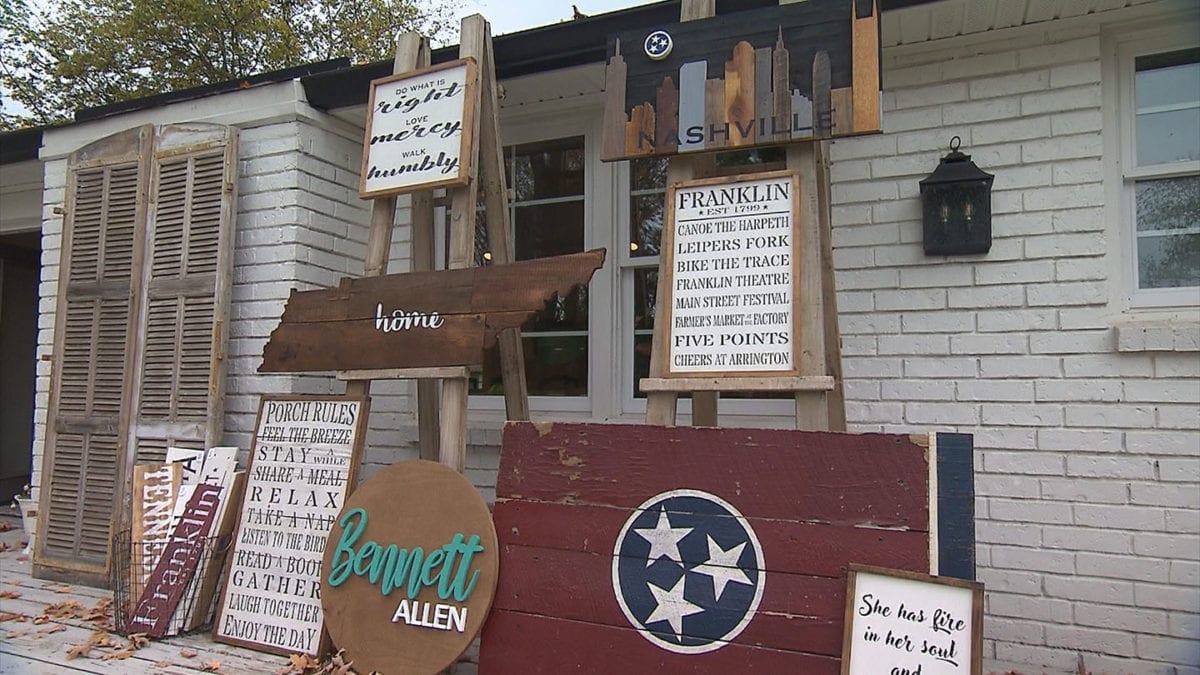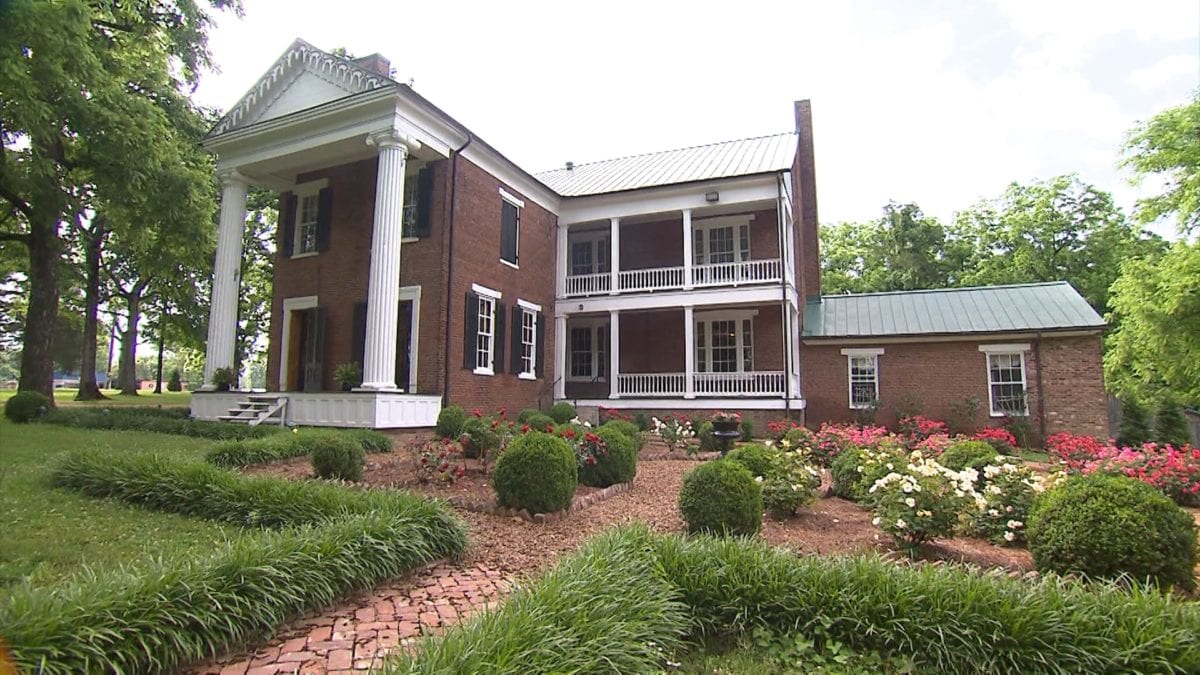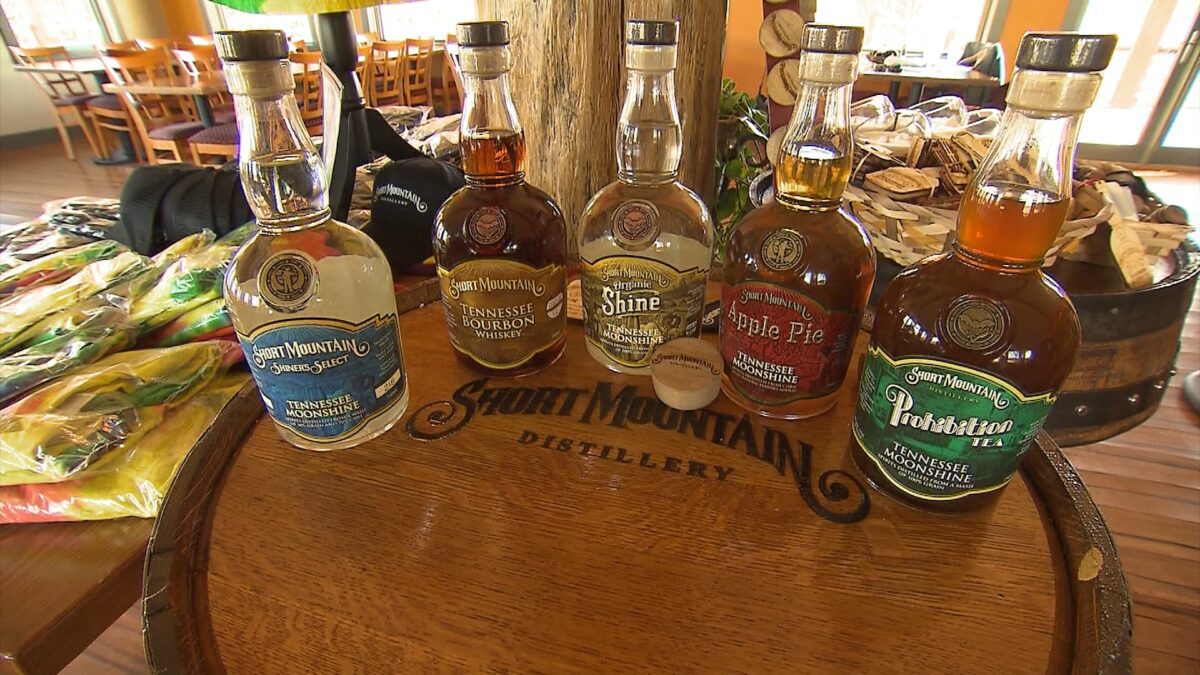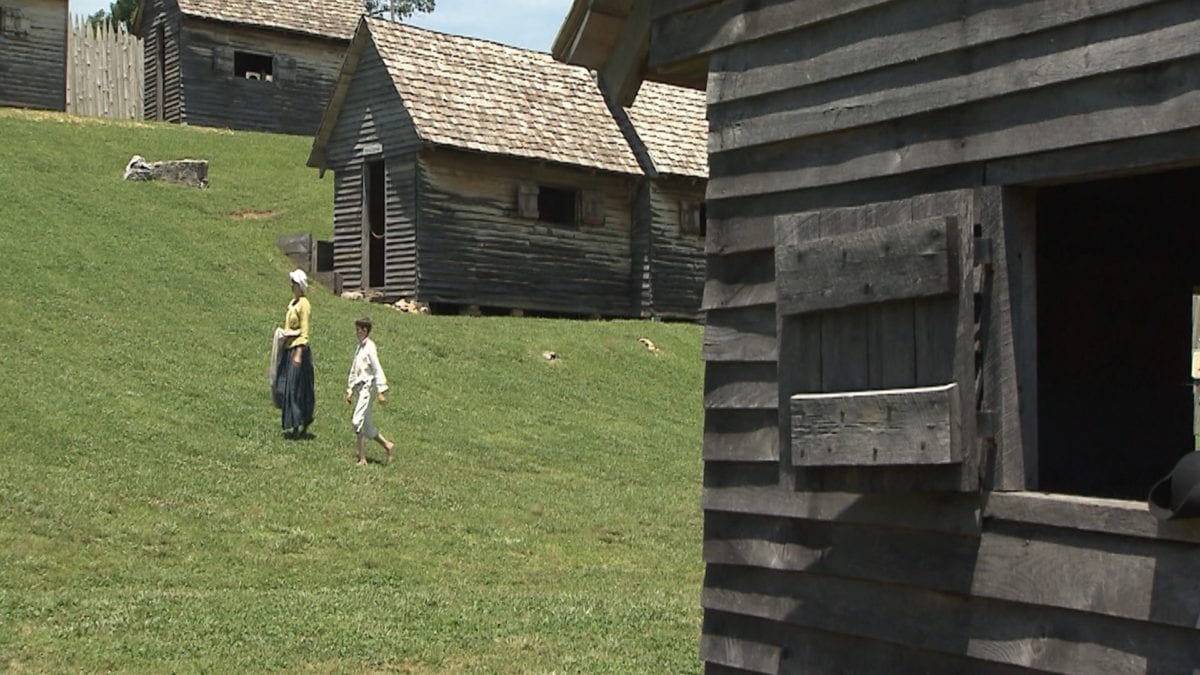- This time on Tennessee Crossroads, we discover the unusual artistry behind Good Day Gifts in Franklin, then explore the past at the Rose Mont Home at Gallatin. We'll lift our spirits at the Short Mountain Distillery in Woodbury, and wind up at an East Tennessee Fort and museum. That's the lineup, the show is Tennessee Crossroads, I'm Joe Elmore. Welcome. Someone once said, "if you work with your hands and your head, well, you're a craftsman. If you work with your hands, head, and your heart, well, you're an artist." Laura Faber introduces us to one such artist in Franklin, who's a wife, a mom, and the hands, head, and heart behind Good Day Gifts.
- [Laura Faber] When the saws start buzzing and the wood chips and dust start flying, you know a project is underway in Lori Sessler's Franklin studio. Over the past decade, the Sessler family cars have been forced out of the garage to make way for other machines: drills, a planer, a router, and saws lots of them. A scroll saw, miter saw, table saw, jigsaw, circular saw, and an oscillating multi-tool.
- [Lori Sessler] I did get this bandsaw one year for Christmas, you know?
- [Faber] Okay. Now that is not like a piece of jewelry, but it probably made you just as happy, right?
- That's one of my favorite tools. Yes.
- [Faber] Lori Sessler is the creative artist behind Good Day Gifts, a custom woodworking and interior design company.
- So I started making small things 10 years ago, and it's just grown and grown and grown over the years. So, it's really been more full-time the past four or five years. I really didn't have a big plan. Like, if you would've told me 15 years ago that this is what I was going to be doing I wouldn't have believed you. I mean, I didn't see this kind of coming.
- [Faber] On this day, Sessler is working on a couple of projects. With her bandsaw, she is cutting reclaimed cedar, which came from a fence post.
- I'm going to be making a six-foot Tennessee. It's already partially done, but I'll be cutting some of that out. And then piecing that together. I do enjoy working with old wood, but there's lots of challenges in that. There's irregularities. There's warping. There's, you know, it's, it's, it's a little more work than just going to, you know, the hardware store and buying a piece of plywood-type thing.
- [Faber] A photo of the finished piece proves this is no ordinary piece of plywood. Beautiful. On Lori's table saw, she again is using reclaimed wood to create a modern frame to display stained glass for a client.
- She gave me some pieces of stained glass that were in her family, that were significant to her family, and really important to her. And she asked, "what do you think we could do with this to kind of help incorporate it into my house? It's really important to me and my family, but the style's a little bit different. So how can we, like, kind of bring these worlds together?"
- [Faber] Laurie's love of old wood can be seen in the stacks of it around her home. Future work to be announced, her family finds it. And often, people donate. The darker wood in this stack is from an old tobacco barn they helped deconstruct in Ashland City.
- That wood is amazing. It still has, like, if you sand it a little bit it still has the tobacco smell. It's got a darker tan on it, things like that that, like, tell a story, I think those are really neat pieces.
- [Faber] Sessler's work ranges from wooden signs to furniture. One of my favorites, this cutout skyline piece. One of Lori's favorite things to make is when she can create a Tennessee piece made with Tennessee wood. This is Hickory wood, the original red paint from a barn in Center Hill Lake. And it's got a piece of Tennessee Oak along the side.
- [Sessler] You can take old wood, and you can clean it up and give it a new life. And I love the heart behind that, and I love that, "Hey, we don't have to throw all this away. Let's give it a new chance." Like, turn it into a table, turn it into a sign, turn it into something that can bring purpose to somebody else and bring value.
- [Faber] Sessler's work can be intricate. She painstakingly uses a scroll saw to cut exact letters, which eventually become cheery works of art, but the best part of all: the relationships that develop with her clients, creating beauty that lives in their homes.
- It's really such an honor. And I, I love being a part of that. And one of my favorite things about my job is the interaction with clients and getting into their world. Like, finding out what they need and filling that void. You know, that that small part is such a gift to me to to be able to make with my hands to make something new and make something that fills that that space that they need. So it's, it's been incredible. It's been really quite a ride.
- [Elmore] Thanks, Laura. Tennessee is full of historic old homes and thanks to preservation efforts, many have regained their original luster. Well, such is the case of Rose Mont in Gallatin. We're about to explore a home inhabited by one single family since it was built in 1842. And as you'll discover, the design is as unique as the colorful past. Rose Mont sits proudly on the south side of Gallatin and was once the centerpiece of a 500 acre horse and cattle farm. It's both an historical family home and an architectural anomaly of middle Tennessee.
- [Cass Holly] This is a classical Palladian-inspired Louisiana Creole plantation house plopped down in the middle of Tennessee.
- [Elmore] That's Cass Holly, a descendant of Rose Mont's original owner. Josephus Conn Guild was a prominent Tennessee attorney, author, soldier, politician, and thoroughbred horsemen. He built Rose Mont for his family, completed it in 1842, and spent most of his life here. It was inspired by plantation homes he had seen in New Orleans during horse racing events.
- [Holly] This house is three separate brick houses linked by two-story galleries.
- [Elmore] With a layout like this, family members had to come up the stairs and onto this open porch on the second floor to get to their rooms. Now, the advantage was better ventilation and circulation of air. The disadvantage? Well, you froze to death in the winter. Cass's late grandmother, Joan Brown Guild, was the last descendant to live at Rose Mont, and Cass spent much of his youth surrounded by this 19th century family history.
- [Holly] Growing up with family portraits and overwhelming aura of antiquity. Yeah, we grew up on stories of race horses and the civil war, just life here. We really grew up in the 19th century in an odd way.
- [Elmore] By the early 1990s, Rose Mont was in desperate need of restoration, and its fate was of critical concern.
- We'd all lived away and none of us really wanted to move back here. And Miss Ellen Wemyss was a close family friend and she stepped in. She inspired a lot of people in town to take an interest and we formed Rosemont Restoration Foundation, and they now are the caretakers here.
- [Elmore] Another Judge Guild descendant, Lee Bradham, is president of the board.
- What my job is, is to promote and preserve this place. Not only the history of it, but it's also a wonderful venue for weddings. And we have a reception hall in the back for that.
- [Holly] Joe, this is the plantation office and the most elaborate room in the house, oddly enough. I think it was also the gentleman's parlor. The woodwork in here was grain-painted to look like English Oak. And most of this is the original graining.
- Cass is an artist by profession, and here are portraits he painted of a younger Joe Guild and his wife, Catherine, along with those of Guild's favorite thoroughbreds.
- The Union Army has sentries stationed out here at the gates. Uncle Ike, the head groom on the place, he was the only male left on the place during the war, he would give the sentries corn whiskey late at night and wait until they passed out. And he and the other grooms would bring the horses out from the basement and exercise them in the back pasture until daybreak. This is the ladies' parlor. And unlike most houses in Tennessee, once again the Louisiana Creole thing, you, the front door opens directly into the front parlor. And these were some of the very first sliding doors in the state from late 1830s. This was the children's bedroom, I guess the nursery and the girls also. And it was above the master bedroom so they could keep tabs. That's the original 19th century cradle that belonged to my great-great grandmother. And I think we all spent time in that cradle when we were children.
- Across the gallery are quarters once called a garconniere. In today's terms, well, think "bachelor pad."
- Once you reached 12 or 13, the boys were moved out of the children's bedroom and kind of did their own thing, watched over by servant.
- In the middle are a couple of guest rooms. The Guilds entertained many notable visitors, such as presidents James Polk and Andrew Johnson. Outside, there's a replica of the family's detached kitchen furnished in 19th century fashion, of course. And yes, there's a rose garden.
- This is, this is a miracle. I get emails from people in town all the time about how much they love the place and love the fact that they can use it. And it's, it kind of belongs to them now. As well as us.
- Today, Rose Mont stands as a lasting tribute to the only family that lived here for more than 160 years. Now, also a showplace of history and architectural beauty to be shared by all. This state is state is well-known for its distilleries. There are 26 on the Tennessee Whiskey Trail. Well, the Cannon County Distillery Gretchen Bates is visiting in our next story isn't quite a household name yet, but it has plenty to make a day-trip worthwhile. ♪ Come and listen to my story 'bout a man named Jed ♪ ♪ Poor mountaineer, barely kept his family fed ♪
- [Gretchen Bates] You're probably familiar with Jed's story which is the opposite of our story. While the Clampetts found bubbling crude and went to Californy, Billy Kaufman left Beverly for the hills of Tennessee. And while when he found bubbled all right, it wasn't black gold. It was white lightning. But Billy's journey, which led to the creation of Short Mountain Distillery, originally had nothing to do with drinking corn, but growing it, as our tour guide explains.
- My name is Jeff. Hello, welcome. Welcome to Little Short Mountain Farm, ladies and gentlemen. When he got this place, it was all about "I just want to get away" which he was actually from Beverly Hills, California. Can you believe that? And wanted to settled down, "if I can, I'd like to try to establish an organic farm," if he could. So he got this place and that was the aspiration.
- [Billy Kaufman] It took a few years, but I realized after a while that people weren't really making their money small farming and what they were really doing was making money moonshining. They've been doing it here so long, everyone is related to a moonshiner, whether they like it or not. Tell, tell him how you blew yourself up.
- Are you filming already?
- [Bates] Meet Ronald Lawson and Ricky Estes, Billy's co-conspirat--business associates, two Cannon County natives with a vast knowledge of what granny called "tonic."
- [Kaufman] You want to hear stories about moonshiners trying to outrun the law or anything like that. You should talk to Ricky and Ronald. Ricky has been caught, you know, a bunch of times, probably.
- I love to make moonshine. I born and the whole, my whole family were moonshiners.
- And Ronald has never been caught.
- They wouldn't, I outsmarted them. It was just pure luck.
- Their personalities are very different. Even though, for decades they've been making the same exact recipe.
- [Bates] Who makes better shine?
- I think I do, Ricky thinks he does.
- It's the way it is. You know, you try to do the best with it.
- Ronald was the first person to introduce me to Tennessee moonshine.
- Good moonshine has to have that good mellow corn taste and you feel that warm feeling coming back up.
- That's right.
- If you drinkin moonshine and quick as you drink it and it just burns you up, it's not good shine.
- [Kaufman] It was just so foreign to me. And when I tried it, I really loved it. It became my favorite spirit
- [Bates] For many years, making that spirit might have resulted in a change of address. Hey, what about my phone call? Luckily, for Billy and friends that changed a few years back.
- [Jeff] The Tennessee legislature deregulated hard liquor. Well, what do you think Billy thought when he heard that? Yee-haw! He was ready to do it then.
- [Bates] Ready, willing, but unable to finance it on his own. So Billy followed the example of other moonshiners and made it a family tradition.
- [Kaufman] When we knew that it was a possibility to have a distillery in Cannon County, I called my brothers and they both decided to help me finance the distillery. And my brothers and I thought it was a good idea to put our family value, the golden rule, on every bottle that we produce. So, if you look at one of our bottles you can see a coin on it, and on the back are the three stars of Tennessee and the golden rule. And now we're making things that we made before prohibition like Tennessee whiskey and rye whiskey and bourbon and all of that's starting to come out now because we've just matured as a real distillery. There's no bells and whistles. It's just really good corn, organic corn. If we can do it really good rye, really good malts grind them fresh all here, pure spring water.
- [Bates] Pure water that owes its quality to the distillery's namesake.
- [Kaufman] Short Mountain is one of the last little outcrops of the Appalachians. And it's filled with limestone and little crevices and caves. And when it rains on Short Mountain, it gets filtered down through that limestone and all around Short Mountain there are these springs and one of them actually used to be the spring where Cooper Melton made moonshine for Al Capone. And we used that spring to supply all of our water here at the distillery.
- [Bates] After you've toured the distillery, it's just a short walk to the Stillhouse Cafe, where you can grab a bite to eat and sample the spirits.
- [Kaufman] We don't just want to be like a regular distillery tour. We try and give people a lot of hands-on experiences. And one of the things that we do is we have a cocktail class and this cocktail class is all about having a good time and learning how to make classic cocktails with our spirits. This place is not very far away from Nashville, Knoxville, Chattanooga, but it's a different world. That's what it's all about. It's really about getting out of the hustle and the bustle and coming somewhere where there's not going to be big crowds, where you're going to be able to walk through the woods, and hear the birds, sit outside and watch the cows graze. We just encourage people to come out here and experience the place and enjoy themselves.
- Thanks a lot, Gretchen. Historic locations might be lost to progress, but they can be recreated sometimes to remind us of the events that took place there and the people who were at the center of those events. Rob Wilds went to Loudoun County in East Tennessee to see two to such sites: a historic fort and a museum remembering a world famous linguist.
- [Rob Wilds] Meet Will Kenton.
- I'm a park ranger here at Fort Loudoun, I'm a park ranger officially.
- I'd have say the, the park ranger uniforms have changed since the last one I was at. What, what do you got on today?
- Well, at your cultural areas, your historic parks, we do a lot of living history interpretation. So, today I'm dressed as a soldier who would have been here at Fort Loudoun 250 years ago.
- Fire!
- [Wilds] Back when the enemy the walls were meant to keep out was the French.
- [Kenton] Fort Loudoun was in use from 1756 through 1760. It was the first English-speaking settlement west of the Allegheny mountains. First one in what would one day be Tennessee. The people came here and built this fort because of the military might of the Cherokee. They had to have that alliance.
- [Wilds] So out marched British soldiers from South Carolina to build the fort. And the Alliance with the Cherokee... Well, it lasted for a while.
- Large powerful Cherokee nation, our enemies aren't coming through this valley unless the Cherokee let them. And so in so many respects, Fort Loudoun is the testament of the military might of the Cherokee nation, even down to the way it fell. When Fort Loudoun fell to the Cherokee in August of 1760, it was only a British Fort in North America to fall to force made up solely of American Indians.
- [Wilds] The Cherokee burned the original fort, and later, the creation of Tellico Lake flooded the area. But a replica was built on this site, sticking close to the original plans.
- [Kenton] Here at Fort Loudoun, they had sawyers as part of their construction crew. It was their job to rip the boards and make these clapboard buildings. That's Barracks Road that you see stepping down the hill. In the early stages of construction, the design had for there to be one chimney connect in each two buildings. Captain Demeré saw the work that the mason was doing, was not impressed, and had the chimneys pulled down, thinking those were going to fall and kill his troops. So, they went instead with the chimneys being on the backside, the West side of those buildings. But the buildings you see here today are built on the footprints of originals. The ground's been raised up 17 feet to get the lower part of the fort above the high-water mark, but we've got the archeological data. We've even got the diagrams, the drawings written up in the early days of Fort Loudoun to base those on.
- [Wilds] So visitors come from around the world to see what used to be.
- Present! Fire!
- [Wilds] In one of those ironies that history so often presents us, the Cherokee destroyed the fort, then much later, the lake destroyed much of Cherokee history.
- The nearest Cherokee town of Tuskegee, birthplace of Sequoyah was just beyond that building. It's now flooded. So a huge piece of world history is underneath the water just beyond that house but that town of Tuskegee sprung up outside the new Fort Loudoun. To be close to the British fort. Just a short distance, further up, the Cherokee town of Tanasi, namesake of our state. It's also flooded, but the over hill country, this is the, this is the home to numerous Cherokee towns. It's the birthplace of many Cherokee leaders. It's very rich in Cherokee history.
- [Wilds] Fortunately just down the road from Fort Loudoun, Cherokee history is recalled. And one giant of a man is remembered. The Cherokee, Sequoyah, who created a singular achievement, according to Charlie Rhodarmer, director of the Sequoyah Birthplace Museum.
- [Rhodarmer] Sequoyah never had an education. He never learned English, German, French, to read or write in any language. Here, he's challenged with academic deficiency. On his own, over a 12 year period, develops a writing system by himself. And no one else has done that.
- [Wilds] Sequoyah was an artist, a trader, a silver smith, a blacksmith, and the creator of a whole language, even though he had his challenges from birth.
- "Sequoyah" can translate from Cherokee into English to mean "pig's foot." Sequoia had a limp, that he walked, had a physical challenge.
- [Wilds] Of course, that didn't stop him. He first created a numbering system to allow him to keep track of who owed him what in his blacksmith business. And then...
- [Rhodarmer] And it's in his blacksmith shop in 1809. There's a group of Cherokee standing around and Sequoyah announces to this group of Cherokee, "You know, we could create a writing system. We could put our words on paper. Just like the English can put their English on paper. We could do that." And so in 1809, he begins a 12-year journey and trying to create a writing system, which he finally finished in 1821.
- [Wilds] The museum tells us about the man and about his people.
- [Rhodarmer] What you'll see is some of the different periods of the different peoples that were here in the Over Hill, over the last 10, 12,000 years. And then we have exhibits that talk about the kind of the fort period, when Fort Loudoun was built. We also have exhibits that talk about the silvering and show you the examples of Sequoia's work
- [Wilds] Work that was historic. Places that are historic, recall for us at Fort Loudon and the Sequoyah birthplace museum, both in Loudoun County.
- Oh, where does the time go? Ours is just about up, but I will remind you to visit our website, Tennesseecrossroads.org., when you get a chance. Follow us on Facebook. And by all means, join me back here next week. See you then.




